The greatness of the universe in numbers, and a little in pictures
Hi, habrovchanin!
This post is a thought out loud, a cry from the heart, just thinking, as well as a small count. I hope this topic will make you think and think a little bit. Or maybe just take pleasure in beautiful pictures.
I would like to show how small we are in the endless expanses of space. And how impossible it is for us to break away from the little grain of sand that gave birth to us, and now it is warming and feeding. Using the synonyms of the words “small” and “insignificant” in relation to earthlings, I do not in any way want to show that we really are. After all, we had the honor to contemplate the beauty of space. Thus, I just want to emphasize the greatness of the world around us.
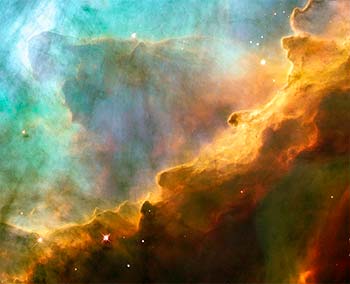
')
We did not manage to fly far away, at least beyond the limits of the Solar System. And our system is just a backyard compared to a full interstellar journey through the metropolis Universe. But, thanks to technology - in particular telescopes - a person is able to look into the space of the universe, and to see it at least as it was many years ago.
So far, telescopes are the only way to travel so far. The most famous of these is undoubtedly Hubble. No doubt, the photographs taken by him were seen by anyone who was not even interested in space. Therefore, I want to begin with them an understanding of how insignificant we are.
Looking at the photographs taken by Hubble, it is quite clearly seen that a small section of space around our native star with its most beautiful views of the planets, comets, asteroids and the Sun itself is just a gray spot in comparison with the colors of the distant space surrounding us.
So, let's begin.
The Crab Nebula is a supernova remnant, an explosion that has been observed, according to records of Arab and Chinese astronomers, on July 4, 1054. The outbreak was visible for 23 days with the naked eye, even in the daytime.
In the center of the nebula there is a pulsar, which is a neutron star left after a supernova explosion, its diameter is only about 25 km . It rotates around its axis, making 30 revolutions per second .
This composition is made up of 26 images taken in October 1999 and January and December 2000.
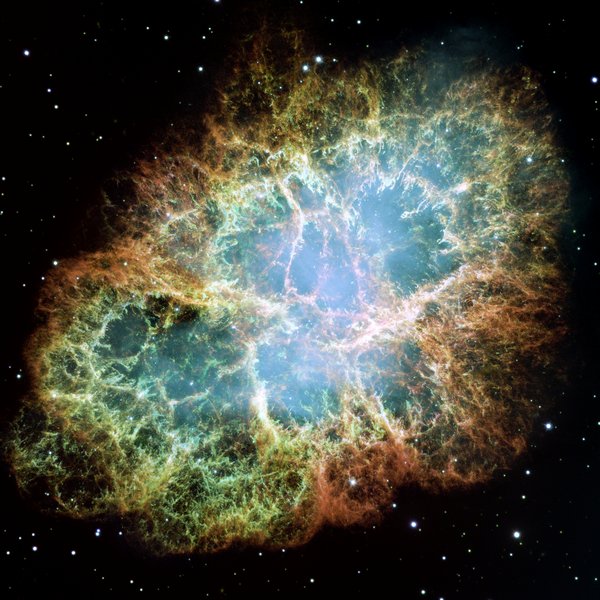

The Eagle Nebula attracts the eye with at least two photographs.
The famous photo, known as the "Pillars of Creation . " Here is the active star formation region. The dark areas in the nebula are protostar.
According to the Spitzer infrared telescope, the “Pillars of Creation” were destroyed by a supernova explosion about 6 thousand years ago. But since the nebula is located at a distance of 7 thousand light years from Earth, it will be possible to observe the Pillars for about a thousand more years .
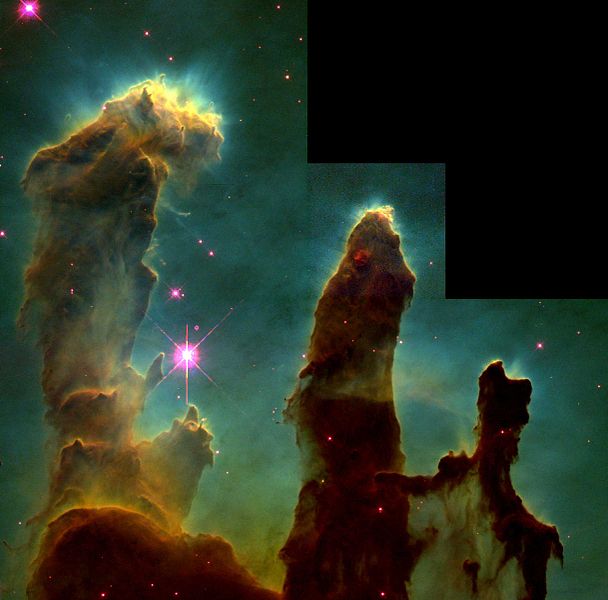
Fairy. The height of the column of dust and gas emerging from the nebula is about 90 trillion kilometers , which is twice the distance from our Sun to the nearest star.

Sombrero Galaxy is a spiral galaxy in the constellation Virgo at a distance of 28 million light years from Earth. As shown by recent studies of this object with the Spitzer telescope, there are two galaxies: the flat spiral is located inside the elliptical one.
A very strong X-ray radiation is due, in the opinion of many astronomers, to the presence of a black hole with a mass of a billion solar masses in the center of this galaxy.
The sombrero is moving away from us at a speed of 1000 km / s .

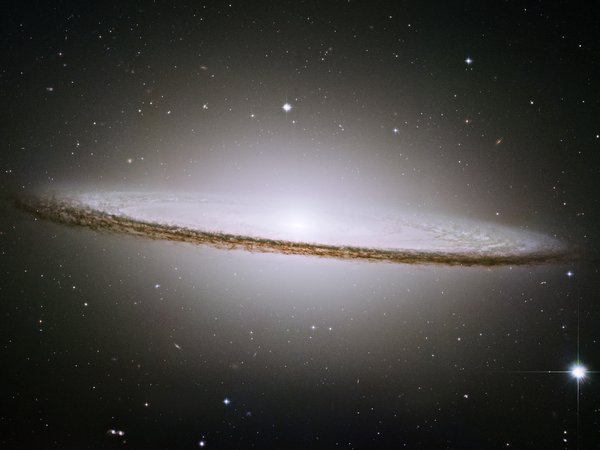
I will complete the slide show with a stunning image of the Karina Nebula. It was obtained using three filters. Red is sulfur, green is hydrogen, blue is oxygen.
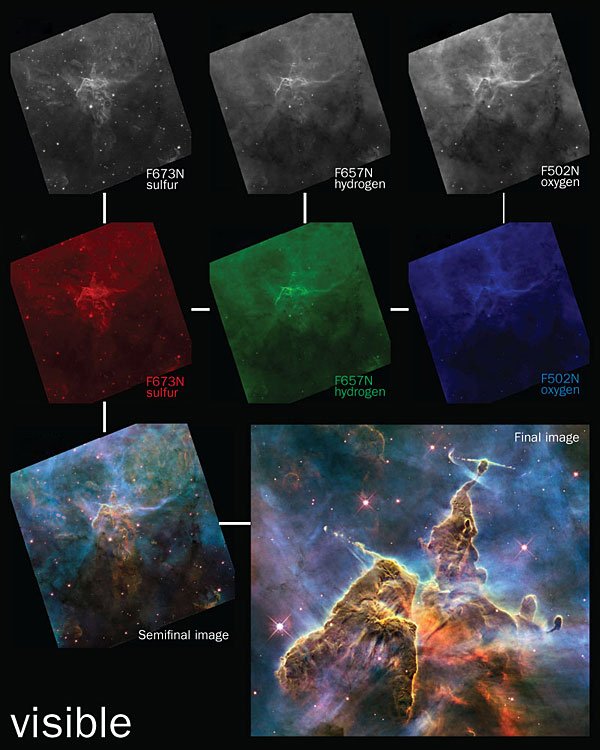
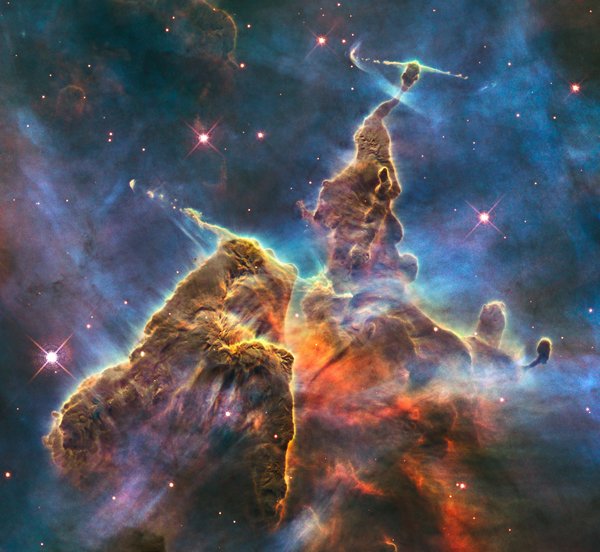

Here you can find more pictures made with the Hubble telescope.
Of course, almost all the images are not made in the usual spectrum of light to our eyes. The authors of these versions of the photographs have tried to add colors to stunning pictures using X-ray, infrared, gamma radiation, as well as the luminescence spectra of various chemical elements. That is, if we really flew past one of these places on theEnterprise ship, we would see a slightly different picture (meaning colors). But, I think that from this she would not have become less majestic.
The whole importance of telescopes is that they (so far) are the only man-made devices that connect us to the Universe. Therefore, man had no choice but to invent ways to explore the cosmos from the resulting image. At least two immediately come to mind. Red shift and parallax .
Both of these methods allow us to find out the speed, distance and time. But just the speed and distance in space are enormous. Exactly at this moment our brain comes to a standstill. 1000 kilometers per second is how fast? And is it possible to imagine a light year? A million years, how long is it?
Bare numbers give nothing. Because they are so big that they look just like numbers. We give several meanings in the customary for us here on Earth.
1000 km / s = 3 600 000 km / h
1 light year = 9,460,730,472,580 km
1 astronomical unit = 150,000,000 km
Do you see?
I have always liked comparisons, such as "Earth is as many times as large as an apple, as apple is more than a molecule."
Such comparisons shed some light on large or small quantities.
Let's try. To make it a little clearer, you can introduce more "earthly" measures.
For example: to understand the speed of light - 300 000 km / s, we can say that the light in 1 second can go around the earth 7.5 times.
Or, to fly a light year, you need to fly 31 620 times to the Sun and back.
But even such examples do not always save, because the distance to the Sun is also not so small.
We need to start with less.
The diameter of the Earth is only 12,742 km. This we can imagine easily. Traveling by train (a little more than a day for 1000 km) through the Earth would take us 2 weeks. The circumference of the Earth is 40,000 km. By train - one and a half months! Not so little.
Although, on the other hand, not so much. Let's go further.
To the moon 363 104 km. She is very close. On the train we would drive to it a little over a year! By plane (1000 km / h) 15 days.
To the orbit of Mars in a straight line on average - 42 000 000 km, on an airplane from us this journey will take almost 5 years! In fact, longer, because the red planet is more often farther from us than the distance between the orbits of the Earth and Mars, and due to the limitations of interplanetary travel, it is impossible to fly directly to any of the planets. For example, Curiosity - flew to Mars a little more than 8 months. During this time, he traveled 563,000,000 kilometers (due to a complex spiral trajectory, almost 4 times as much as the distance from the Earth to the Sun is proof ). The speed of the module, judging from this source, reached 36,210 km / h. (What is a little strange, a simple calculation shows that in 253 days 563 million km can be flown at a speed not less than 92 720 km / h, but those who know this phenomenon will explain to us). But that's not the point.
The highest speed with which a person ever moved (39897 km / h) was developed by the Apollo 10 basic module at an altitude of 121.9 km from the Earth’s surface when the expedition returned on May 26, 1969. The Voyager speed is 48,000-61,000 km / h (Voyager 1). But, the speed record of the spacecraft - 240,000 km / h - was set by the US-German solar probe Helios-B, launched on January 15, 1976.
Thus, for our new comparisons, we can safely introduce 2 new objects Voyager-1 and Helios B.
In a straight line to the Sun - 150,000,000 km.
The train is no longer relevant :) (For interest - 410 years)
The plane is 17 years old.
Voyager 1 - 3.5 months.
Helios B - 26 days.
Already clearer. But this is not so far. Even on a plane, a person can get there during his life.
The latest planet of the Solar System is Neptune. Before it - 30 AU, which is about 4 500 000 000 (4.5 billion km).
So, on the plane - 513 years. (it also becomes irrelevant)
Voyager 1 - 8.5 years.
Helios B - 2 years.
Well, the planets will admire us quite well today.
A lot of letters, it's time to show a picture.
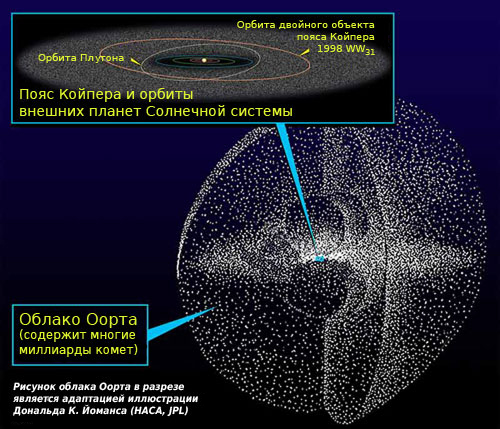
For now, we got to Neptune. (The upper picture is a barely noticeable blue orbit).
Next we jump immediately to the Oort Cloud , because everything interesting is closer to him (Kuiper belt), only 2-3 times farther than the orbit of Neptune.
The distance to the outer boundaries of the Oort cloud from the Sun is from 50,000 a. e. (about 1 light year) to 100,000 a. e. (1.87 light years).
Since Saturn has long been considered the edge of the Solar System, the latter has “grown up” a little today. Or rather 9.5 a.e. up to 125,000 a.e - 13,000 times. According to some scientists, the edge of the Solar System is now considered to be the predominance of the gravity of the Sun over the gravity of the surrounding stars, which is just 125,000 AU. (about 2 light years).
How much time does Voyager 1 need to fly the distance that the light will take a year? The answer is about 18,000 years old.
On November 28, 2012, Voyager was 122.589 meters away. e. or 18.339 billion km from the Sun. He spent 35 years on this! Since 1977.
In the picture above, the blue line showing the circumference in the center of the Oort cloud is too thick to cover at least the last 10 years of the Voyager path!
And on the images from Hubble, even 1 pixel will be, roughly speaking, too big to show the Oort cloud.
We continue the calculations. From the Sun to the edge of the cloud, the Oort Voyager 1 would have flown in 35,409 years, and Helios B in 9,000 years.
So much for the distance of space compared to our capabilities.
Imagine that we would leave the limits of the Solar System. What would we have achieved? What did you see? Of course, very many important data on galactic matter and the solar wind would have been obtained, but the sky here would look quite dull. Alone the stars around. No planets, no sun. That is, 9000 years old, and we would barely have come off the sun.
The nearest interesting object is the Alpha Centauri system, consisting of the stars Alpha A, Alpha B and Proxima Centauri. The distance to these stars is 4.36 light years.
Just a little further, is the star of Barnard. The second closest to the Sun is 5.96 light years.
To them, respectively, 4 and 6 times further. The closest star Helios B would reach in only 36,000 years. This is about half the time of human existence on Earth. The flight to the nearest star does not significantly exceed the flight beyond the limits of the Solar System. This is sad.
Of course, both events would most bring us closer to the stars. I do not want to detract from the achievements of mankind. But, for now, unfortunately you can only dream about it.
New developments can brighten up a little picture.
Several projects:
Two modifications of the Orion project (1950) - The first modification was to reach Alpha Centauri in 1800 years, the second - with a maximum speed of 10,000 km / s in 130 years.
The Daedalus Project (1973) was set up to fly to the star Barnard in 40-49 years.
Both projects, unfortunately, are already closed. But to be honest, they smack of fantasy more.
Here is a complete list of projects , I will not talk about each, but the Annihilation Engine looks quite promising.
With it, you can theoretically accelerate to 70% of the speed of light! But it’s too unattainable to hold antimatter for long enough.
In general, for now you can even dream of 0.1 speed of light. But, in this case, the resistance of the substance of the inter-space space will not allow us to feel normal in our ship.
About the dreams of mankind there is a good article on Habré . And there is this very interesting reference in it, I advise. But let's finish, nevertheless, with numbers.
Finally, imagine for a second that we could ever accelerate to 10 million km / h - this is one-hundredth of the speed of light. In this case, perhaps we will not interfere with the oncoming particles of interstellar space and even 10 000 000 km / h - an impressive speed.
Then:
To the Sun - 15 hours. (promisingly)
Before the Oort cloud - 108 years. (already alarming)
To the nearest star - 432 years. :(
The center of the Milky Way is 5.3 million years old.
Before the Large Magellanic Cloud - 18 million years.
To the Small Magellanic Cloud - 21.5 Ma
Before the Andromeda Galaxy - 270 billion years!
It can be seen that in this case too, the person in his life’s path shines only to fly out of the Solar System.
Of course, for a traveler, this time may be slightly compressed due to the approach to the speed of light, according to the Special Theory of Relativity. But I, unfortunately, with my knowledge I can not say exactly how much. Alas, even with this, the prospect, if more real, then certainly not close.
What happens?
And it turns out that we, for the time being, are destined to admire the beauty of the universe only through telescopes.
I hope I have brought your understanding of the greatness of the World (and my own (at the time of writing)) a little closer.
Waiting for corrections on calculations, if where was wrong and additions. Especially on new developments and speeds.
============
Add-ons from the comments.
The small plus is that the Andromeda galaxy and the Barnard star are moving in our direction. Therefore, we fly up to them a little bit faster!
Here are a couple of proofs from Wikipedia.
The Andromeda Galaxy, like the Milky Way, belongs to the Local Group, and moves towards the Sun at a speed of 300 km / s. Having determined the direction of the Sun's motion along the Milky Way, astronomers found out that the Andromeda galaxy and our Galaxy are approaching each other at a speed of 100-140 km / s.
The lateral velocity of the “Flying Barnard” relative to the Sun is 90 km / s, the radial speed is 106.8 km / s towards us (measured by the Doppler shift).
The star is approaching the sun. The minimum distance will be 3.8 light years (1.2 pc) at 11,800; At this time she will be our nearest neighbor. Naked eye is not visible.
This post is a thought out loud, a cry from the heart, just thinking, as well as a small count. I hope this topic will make you think and think a little bit. Or maybe just take pleasure in beautiful pictures.
I would like to show how small we are in the endless expanses of space. And how impossible it is for us to break away from the little grain of sand that gave birth to us, and now it is warming and feeding. Using the synonyms of the words “small” and “insignificant” in relation to earthlings, I do not in any way want to show that we really are. After all, we had the honor to contemplate the beauty of space. Thus, I just want to emphasize the greatness of the world around us.

')
We did not manage to fly far away, at least beyond the limits of the Solar System. And our system is just a backyard compared to a full interstellar journey through the metropolis Universe. But, thanks to technology - in particular telescopes - a person is able to look into the space of the universe, and to see it at least as it was many years ago.
So far, telescopes are the only way to travel so far. The most famous of these is undoubtedly Hubble. No doubt, the photographs taken by him were seen by anyone who was not even interested in space. Therefore, I want to begin with them an understanding of how insignificant we are.
Photos of the Cosmos
Looking at the photographs taken by Hubble, it is quite clearly seen that a small section of space around our native star with its most beautiful views of the planets, comets, asteroids and the Sun itself is just a gray spot in comparison with the colors of the distant space surrounding us.
So, let's begin.
The Crab Nebula is a supernova remnant, an explosion that has been observed, according to records of Arab and Chinese astronomers, on July 4, 1054. The outbreak was visible for 23 days with the naked eye, even in the daytime.
In the center of the nebula there is a pulsar, which is a neutron star left after a supernova explosion, its diameter is only about 25 km . It rotates around its axis, making 30 revolutions per second .
This composition is made up of 26 images taken in October 1999 and January and December 2000.


The Eagle Nebula attracts the eye with at least two photographs.
The famous photo, known as the "Pillars of Creation . " Here is the active star formation region. The dark areas in the nebula are protostar.
According to the Spitzer infrared telescope, the “Pillars of Creation” were destroyed by a supernova explosion about 6 thousand years ago. But since the nebula is located at a distance of 7 thousand light years from Earth, it will be possible to observe the Pillars for about a thousand more years .

Fairy. The height of the column of dust and gas emerging from the nebula is about 90 trillion kilometers , which is twice the distance from our Sun to the nearest star.


Sombrero Galaxy is a spiral galaxy in the constellation Virgo at a distance of 28 million light years from Earth. As shown by recent studies of this object with the Spitzer telescope, there are two galaxies: the flat spiral is located inside the elliptical one.
A very strong X-ray radiation is due, in the opinion of many astronomers, to the presence of a black hole with a mass of a billion solar masses in the center of this galaxy.
The sombrero is moving away from us at a speed of 1000 km / s .


I will complete the slide show with a stunning image of the Karina Nebula. It was obtained using three filters. Red is sulfur, green is hydrogen, blue is oxygen.




Here you can find more pictures made with the Hubble telescope.
Of course, almost all the images are not made in the usual spectrum of light to our eyes. The authors of these versions of the photographs have tried to add colors to stunning pictures using X-ray, infrared, gamma radiation, as well as the luminescence spectra of various chemical elements. That is, if we really flew past one of these places on the
Telescopes are not only "Photograph"
The whole importance of telescopes is that they (so far) are the only man-made devices that connect us to the Universe. Therefore, man had no choice but to invent ways to explore the cosmos from the resulting image. At least two immediately come to mind. Red shift and parallax .
Both of these methods allow us to find out the speed, distance and time. But just the speed and distance in space are enormous. Exactly at this moment our brain comes to a standstill. 1000 kilometers per second is how fast? And is it possible to imagine a light year? A million years, how long is it?
Bare numbers give nothing. Because they are so big that they look just like numbers. We give several meanings in the customary for us here on Earth.
1000 km / s = 3 600 000 km / h
1 light year = 9,460,730,472,580 km
1 astronomical unit = 150,000,000 km
Do you see?
Representation of vast distances
I have always liked comparisons, such as "Earth is as many times as large as an apple, as apple is more than a molecule."
Such comparisons shed some light on large or small quantities.
Let's try. To make it a little clearer, you can introduce more "earthly" measures.
For example: to understand the speed of light - 300 000 km / s, we can say that the light in 1 second can go around the earth 7.5 times.
Or, to fly a light year, you need to fly 31 620 times to the Sun and back.
But even such examples do not always save, because the distance to the Sun is also not so small.
We need to start with less.
The diameter of the Earth is only 12,742 km. This we can imagine easily. Traveling by train (a little more than a day for 1000 km) through the Earth would take us 2 weeks. The circumference of the Earth is 40,000 km. By train - one and a half months! Not so little.
Although, on the other hand, not so much. Let's go further.
To the moon 363 104 km. She is very close. On the train we would drive to it a little over a year! By plane (1000 km / h) 15 days.
To the orbit of Mars in a straight line on average - 42 000 000 km, on an airplane from us this journey will take almost 5 years! In fact, longer, because the red planet is more often farther from us than the distance between the orbits of the Earth and Mars, and due to the limitations of interplanetary travel, it is impossible to fly directly to any of the planets. For example, Curiosity - flew to Mars a little more than 8 months. During this time, he traveled 563,000,000 kilometers (due to a complex spiral trajectory, almost 4 times as much as the distance from the Earth to the Sun is proof ). The speed of the module, judging from this source, reached 36,210 km / h. (What is a little strange, a simple calculation shows that in 253 days 563 million km can be flown at a speed not less than 92 720 km / h, but those who know this phenomenon will explain to us). But that's not the point.
The highest speed with which a person ever moved (39897 km / h) was developed by the Apollo 10 basic module at an altitude of 121.9 km from the Earth’s surface when the expedition returned on May 26, 1969. The Voyager speed is 48,000-61,000 km / h (Voyager 1). But, the speed record of the spacecraft - 240,000 km / h - was set by the US-German solar probe Helios-B, launched on January 15, 1976.
Thus, for our new comparisons, we can safely introduce 2 new objects Voyager-1 and Helios B.
In a straight line to the Sun - 150,000,000 km.
The train is no longer relevant :) (For interest - 410 years)
The plane is 17 years old.
Voyager 1 - 3.5 months.
Helios B - 26 days.
Already clearer. But this is not so far. Even on a plane, a person can get there during his life.
The latest planet of the Solar System is Neptune. Before it - 30 AU, which is about 4 500 000 000 (4.5 billion km).
So, on the plane - 513 years. (it also becomes irrelevant)
Voyager 1 - 8.5 years.
Helios B - 2 years.
Well, the planets will admire us quite well today.
A lot of letters, it's time to show a picture.

For now, we got to Neptune. (The upper picture is a barely noticeable blue orbit).
Next we jump immediately to the Oort Cloud , because everything interesting is closer to him (Kuiper belt), only 2-3 times farther than the orbit of Neptune.
The distance to the outer boundaries of the Oort cloud from the Sun is from 50,000 a. e. (about 1 light year) to 100,000 a. e. (1.87 light years).
Since Saturn has long been considered the edge of the Solar System, the latter has “grown up” a little today. Or rather 9.5 a.e. up to 125,000 a.e - 13,000 times. According to some scientists, the edge of the Solar System is now considered to be the predominance of the gravity of the Sun over the gravity of the surrounding stars, which is just 125,000 AU. (about 2 light years).
How much time does Voyager 1 need to fly the distance that the light will take a year? The answer is about 18,000 years old.
On November 28, 2012, Voyager was 122.589 meters away. e. or 18.339 billion km from the Sun. He spent 35 years on this! Since 1977.
In the picture above, the blue line showing the circumference in the center of the Oort cloud is too thick to cover at least the last 10 years of the Voyager path!
And on the images from Hubble, even 1 pixel will be, roughly speaking, too big to show the Oort cloud.
We continue the calculations. From the Sun to the edge of the cloud, the Oort Voyager 1 would have flown in 35,409 years, and Helios B in 9,000 years.
So much for the distance of space compared to our capabilities.
Imagine that we would leave the limits of the Solar System. What would we have achieved? What did you see? Of course, very many important data on galactic matter and the solar wind would have been obtained, but the sky here would look quite dull. Alone the stars around. No planets, no sun. That is, 9000 years old, and we would barely have come off the sun.
The nearest interesting object is the Alpha Centauri system, consisting of the stars Alpha A, Alpha B and Proxima Centauri. The distance to these stars is 4.36 light years.
Just a little further, is the star of Barnard. The second closest to the Sun is 5.96 light years.
To them, respectively, 4 and 6 times further. The closest star Helios B would reach in only 36,000 years. This is about half the time of human existence on Earth. The flight to the nearest star does not significantly exceed the flight beyond the limits of the Solar System. This is sad.
Of course, both events would most bring us closer to the stars. I do not want to detract from the achievements of mankind. But, for now, unfortunately you can only dream about it.
Little sweet hope
New developments can brighten up a little picture.
Several projects:
Two modifications of the Orion project (1950) - The first modification was to reach Alpha Centauri in 1800 years, the second - with a maximum speed of 10,000 km / s in 130 years.
The Daedalus Project (1973) was set up to fly to the star Barnard in 40-49 years.
Both projects, unfortunately, are already closed. But to be honest, they smack of fantasy more.
Here is a complete list of projects , I will not talk about each, but the Annihilation Engine looks quite promising.
With it, you can theoretically accelerate to 70% of the speed of light! But it’s too unattainable to hold antimatter for long enough.
In general, for now you can even dream of 0.1 speed of light. But, in this case, the resistance of the substance of the inter-space space will not allow us to feel normal in our ship.
About the dreams of mankind there is a good article on Habré . And there is this very interesting reference in it, I advise. But let's finish, nevertheless, with numbers.
Finally, imagine for a second that we could ever accelerate to 10 million km / h - this is one-hundredth of the speed of light. In this case, perhaps we will not interfere with the oncoming particles of interstellar space and even 10 000 000 km / h - an impressive speed.
Then:
To the Sun - 15 hours. (promisingly)
Before the Oort cloud - 108 years. (already alarming)
To the nearest star - 432 years. :(
The center of the Milky Way is 5.3 million years old.
Before the Large Magellanic Cloud - 18 million years.
To the Small Magellanic Cloud - 21.5 Ma
Before the Andromeda Galaxy - 270 billion years!
It can be seen that in this case too, the person in his life’s path shines only to fly out of the Solar System.
Of course, for a traveler, this time may be slightly compressed due to the approach to the speed of light, according to the Special Theory of Relativity. But I, unfortunately, with my knowledge I can not say exactly how much. Alas, even with this, the prospect, if more real, then certainly not close.
Total
What happens?
And it turns out that we, for the time being, are destined to admire the beauty of the universe only through telescopes.
I hope I have brought your understanding of the greatness of the World (and my own (at the time of writing)) a little closer.
Waiting for corrections on calculations, if where was wrong and additions. Especially on new developments and speeds.
============
Add-ons from the comments.
The small plus is that the Andromeda galaxy and the Barnard star are moving in our direction. Therefore, we fly up to them a little bit faster!
Here are a couple of proofs from Wikipedia.
The Andromeda Galaxy, like the Milky Way, belongs to the Local Group, and moves towards the Sun at a speed of 300 km / s. Having determined the direction of the Sun's motion along the Milky Way, astronomers found out that the Andromeda galaxy and our Galaxy are approaching each other at a speed of 100-140 km / s.
The lateral velocity of the “Flying Barnard” relative to the Sun is 90 km / s, the radial speed is 106.8 km / s towards us (measured by the Doppler shift).
The star is approaching the sun. The minimum distance will be 3.8 light years (1.2 pc) at 11,800; At this time she will be our nearest neighbor. Naked eye is not visible.
Source: https://habr.com/ru/post/161901/
All Articles